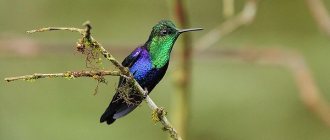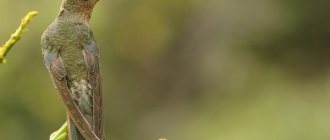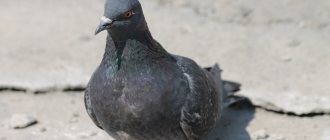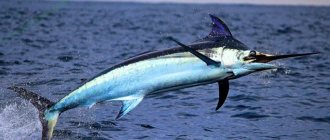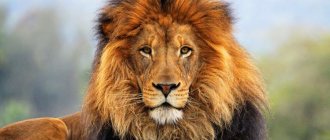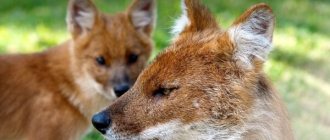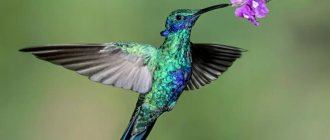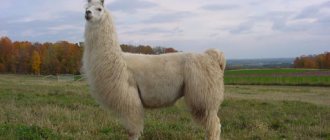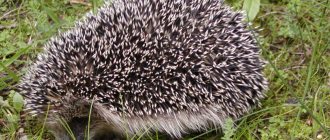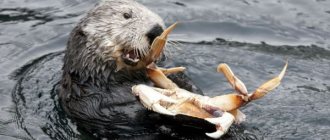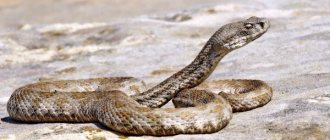Probably everyone has heard the word “hummingbird” in one form or another. But not everyone knows the hummingbird and its fantastic features. This is exactly what we want to tell those who love interesting facts about animals.
I would like to say right away that in many respects this bird is a record holder. Her amazing abilities allow us to include this article under the heading “The best things in the world.”
Hummingbirds are a family of small birds. More than 330 species of hummingbirds are known. They live mainly in North and South America. However, there are species that live in Alaska. The main condition for their existence is the presence of meadows, gardens and fields. Hummingbirds live for 9 years.
The smallest bird in the world
The hummingbird is the smallest bird in the world. Seeing this wonderful creature in person, one can unwittingly mistake it for an insect. An interesting fact is that the smallest bird, the hummingbird-bee, has absolutely miniature dimensions - a maximum of 5.7 cm and weighs only 2 grams. As a rule, they are found in Cuba.
However, do not forget that the largest representatives of this family of birds reach a size of 21 cm.
№14
One of the strangest facts about hummingbirds has to do with how they eat. Many believe that they use their beak to suck nectar from flowers. Not entirely true. Thanks to high-speed cameras, scientists were able to fully study the feeding process of this bird.
As it turns out, they use their tongue as a piston. Thanks to a special organ, the tongue is pushed out of the beak and sucks in nectar like a pump. Depending on the species of hummingbird, their tongue can fire up to 13 “shots” per second.
We also recommend reading: Interesting facts about butterflies
Appearance of hummingbird
The hummingbird bird has stunningly bright colors. Its plumage shimmers and shines in the sun, reminiscent of a sparkling gem. When you see this tiny miracle for the first time, you will be shocked by how the extraordinary color shimmers under direct sunlight.
The names of some representatives of these birds are quite consistent with their appearance. Here are some of them: “Emerald Neck”, “Fiery Topaz”, “Flying Amethyst”, etc.
Top 3: the most interesting facts about hummingbirds
- DNA analysis has shown that new subspecies are still being formed. They appear faster than the old ones die out. It seems that the bird is simply mutating, adapting to its environment.
- Bird feathers sparkle beautifully in the sun. Perhaps this is why ornithologists give them such poetic names: “mountain star”, “emerald”, “forest nymph”.
- In the 19th century, many fashionistas dreamed of showing off clothes decorated with hummingbird skins. These birds were exterminated en masse, and ornithologists can study many species only from surviving accessories.
Hummingbird Family Life
The nests of the smallest birds are made from any “auxiliary” material. These can be blades of grass with cobwebs, animal hairs, and even small pieces of tree bark.
Nest sizes vary from the size of a simple cup to the size of a walnut. And indeed, why does a family of hummingbirds, whose representatives are 3 cm long, need a large nest!
In such a miniature house, the hummingbird lays two eggs, no larger than a pea in diameter.
Despite its limited size, the hummingbird is a very brave bird. She selflessly defends her family when something threatens her. Attacking the enemy with all determination, she pierces the enemy's eyes or nose with her small and sharp beak.
An interesting fact is that hummingbirds do not mate in the same way as birds usually do. Females take care of their offspring independently.
Natural enemies, endangered
In nature, tiny birds have many enemies. They are caught by birds of prey of all kinds, dragonflies and mantises. In populated areas, cats attack; in non-residential areas, they are eaten by snakes and lizards. Even frogs are not averse to dining on a little bird.
Humans also contribute to the disappearance of hummingbirds. Nobody kills birds for decoration anymore, but this does not save them from being caught for keeping in apartments. It is difficult for birds to adapt to urban conditions, and they die. It should be noted that people not only harm these birds. Some feed these birds or care for sick individuals. Now hummingbirds are under protection, and everything is being done to preserve these amazing birds in all their glory.
The article was read by 12,411
Hummingbird feeding
The hummingbird feeds on the nectar of flowers, and does it extremely elegantly and gracefully. Even children know that the hummingbird is the only bird in the world that can hang in the air. Having found a flower, she flies up to it, and if it is impossible to sit on it, she hovers in the air, taking out the precious nectar.
But this requires a lot of energy. Therefore, the hummingbird makes about 80 wing beats per second (!) to stay in the air in one place.
Surprisingly, some types of flowers are such in their structure that only this miniature bird can pollinate them. This is truly mysterious nature!
However, hummingbirds feed on more than just flower nectar. Larger individuals can eat insects caught in the web.
Interestingly, the flight characteristics of hummingbirds require a lot of energy, as we have already said. It is for this reason that she has to eat something every 10 minutes. Thus, she eats more than her own weight in food per day.
Hummingbird: description
The hummingbird family is quite colorful and is known to scientists under the Latin name “Trochilidae”.
In their anatomy, hummingbirds are similar to passerines, since they have a short neck, long wings and a medium-sized head. We can say that this is where the similarities end, since hummingbirds can boast of large varieties of beaks, beautiful colors of feathers, etc., which cannot be said about passerines.
As a rule, males have brighter and more attractive coloring in appearance. At the same time, on their heads there are various small tufts of feathers in the form of crests. The shape of the beak can be either straight or curved in any direction, and also differs in size.
Interesting to know! The upper half of the beak wraps around the lower part, while there are no bristles at the base of the beak. But the hummingbird boasts a long forked tongue, with the help of which the bird feeds on the nectar of inflorescences.
These birds have short and poorly developed legs, so they cannot be seen moving on the ground. They are only able to cling to a branch and stay on it. It should be noted that this bird does not need strong legs, since they spend most of their life in the air, in search of food.
Plumage and wings
In terms of their structure, the wings of a hummingbird are similar to the wings of butterflies, since the bones in them are fused, and a large useful area of the wings is obtained. To control the wings of increased area, strong muscles and a sufficiently mobile shoulder joint are required. Their share in the total body weight of the bird is at least 25 percent.
Although the family has a variety of tail shapes, they all consist of 10 tail feathers. The only exception is the rocket-tailed hummingbird, whose tail consists of only 4 tail feathers. Hummingbirds are called flying jewels due to the presence of bright and varied plumage with a metallic tint. At the same time, bird feathers have amazing properties: their color can change depending on the angle of inclination in relation to the sun's rays, as well as in relation to the angle of human vision.
Hummingbird species
To date, scientists know of 330 classified species of hummingbirds. Among this variety there are both small (very) and large-sized birds.
The largest species is considered the gigantic hummingbird, since its body length reaches 20 cm, or even more. This species is found within South America, even in mountainous areas, at an altitude of about 5 thousand meters. The bird is distinguished by its straight but long beak and tail, reminiscent of a pitchfork.
The bee hummingbird species is considered the smallest of the entire family, as it grows in length a little more than 5 and a half cm, weighing a little more than one and a half grams. The tiny hummingbird is found exclusively in Cuba.
The eagle-billed hummingbird lives in Costa Rica, Panama, Colombia, Ecuador and Peru. Its peculiarity lies in the shape of its beak, which is curved downward, almost 90 degrees.
Interesting moment! The buffy hummingbird, also known as the rufous selasphorus, appeared on the territory of Russia at the same time. This happened in 1976, when this bird was seen on Ratmanov Island, while, according to eyewitnesses, the buffy hummingbird was seen in Chukotka, as well as on Wrangel Island.
The usual habitats of the red selasphorus are North America, and the bird flies to Mexico for the winter. Adults are about 8 and a half centimeters long and have a long and thin beak.
The swordbill is another representative of the family with a rather long beak compared to the length of the body. Its length is more than 10 centimeters, with a maximum body length of 23 centimeters. The main body color of this bird is dark green.
Natural habitats
For their habitat, hummingbirds choose places where there is a lot of fragrant vegetation and flowers. As a rule, such places are located in the tropics.
Almost all hummingbirds are native to the New World. In this regard, their habitat extends to Central and South America, including the south of North America. These are mostly sedentary birds, with some exceptions. The ruby-throated hummingbird is not. Its natural habitats are associated with the northern borders, abutting Canada and the Rocky Mountains.
This type of hummingbird prefers to lead an isolated lifestyle, but with the onset of cold weather it has to fly to more comfortable territories in Mexico. At the same time, the bird covers a route almost 5 thousand kilometers long at a speed of almost 80 km/h, which is quite decent for such a bird.
For most species, their habitat is limited to a specific territory. As a rule, such species are called endemics. A striking example of this species is the bee hummingbird, which lives only in Cuba.
Interesting facts – Hummingbird
Behavior and lifestyle
Despite the fact that hummingbirds are generally not large in size, they are able to fend for themselves when it comes to their living space.
These birds mainly lead a solitary lifestyle, with the most active period observed from early morning and throughout the day. As night falls, their lives change dramatically.
Important point! Due to the very fast metabolism in the body of hummingbirds, these birds need to constantly feed, which becomes unavailable to them at night. In order not to waste their energy at night, hummingbirds fall asleep. As a result, their body temperature drops to almost 17 degrees and their heart rate slows down significantly. As soon as the sun rises, the hummingbirds immediately wake up and a new day begins.
Many people believe that all hummingbirds flap their wings at a frequency of up to a hundred beats per second. In fact, this is not so and the frequency of wing flapping depends on the size of the bird. Most species manage with no more than 10 wing beats.
The flight of a hummingbird is somewhat reminiscent of the flight of a butterfly, but this is only at first glance, since the flight of a hummingbird is much more complex and maneuverable. The hummingbird can fly both forward and backward, not to mention flying sideways. In addition, the hummingbird is capable of hovering in the air like a helicopter, as well as vertically taking off and landing.
When a bird hovers, its wings move in a figure eight, which is inaccessible to most species of birds. At the same time, the movements of the wings are barely captured by the human eye, so their movements often become blurry, which creates the impression of the absence of wings as such.
What do hummingbirds eat?
These tiny creatures are busy throughout the daylight hours, looking for food for themselves and feeding. The metabolism of their body requires constant replenishment of nutrients. To fully provide itself with energy, the bird needs to eat 2 times more per day compared to its weight. At the same time, hummingbirds feed exclusively in flight and you can never see how a hummingbird feeds while sitting on a branch and, especially, on the ground.
It is important to know! The basis of the diet of these birds is nectar, as well as pollen of various plants. At the same time, different types of hummingbirds are characterized by certain gastronomic preferences. There are species that fly from flower to flower, regardless of the type of plant, and there are species that feed on nectar or pollen of certain plant species.
Therefore, scientists suggest that the shape of the beaks of some species of hummingbirds is adapted to the structure of the calyx of a flower of a certain species.
While feeding on nectar, the bird lowers its long tongue into the neck of the flower several dozen times. At the same time, the curled tongue first straightens out and captures the sweet substance, after which it curls again and retracts into the beak. As a result of feeding on nectar and pollen, the hummingbird's body is saturated with carbohydrates in sufficient quantities. But for the normal functioning of their body, they also need protein. In this regard, hummingbirds also catch insects in flight.
Hummingbird. Gems of the animal world
Natural enemies
These birds have virtually no natural enemies, although they can be preyed on by tree snakes and tarantulas. They track hummingbirds among dense tropical thickets, especially when the hummingbirds are sleeping. Well, and of course, humans cause irreparable damage to hummingbird populations by hunting their unique plumage. Some of the species, thanks to plumage hunters, found themselves near the point of complete extinction.
Hummingbird breeding
These small birds are polygamous species, with species found in the tropics breeding throughout the year, while species found in cold regions breed exclusively in the summer. The male can selflessly defend his territory from his relatives, but after mating the female herself takes care of her offspring.
First of all, the female builds a nest for herself from available materials, in the form of grass, moss, fluff, lichen, etc., holding them together with her saliva.
A hummingbird's nest is as small as the bird itself, so it can be the size of half a walnut shell. It takes 2 to 3 weeks to hatch 2 tiny eggs, the size of a pea. During this period, the female manages to provide herself with food and also protects the clutch from natural enemies. She fearlessly attacks either a snake or a spider, plunging her sharp beak into their body.
The tiny offspring that are born need constant food. Therefore, the female carries nectar for them in her beak, constantly moving, now from the nest to the flowers, then vice versa.
Interesting moment! During prolonged fasting, the chicks simply fall asleep, so the female has to wake them up to feed them.
Hummingbird chicks grow very quickly and are able to leave the parental nest 3 weeks after birth.
Hummingbird flight
The hummingbird's flight style is the most unique among all birds. An interesting fact is that the hummingbird is the only bird in the world that can fly backwards. This fantastic ability is due to the fact that the flight muscles of this wonderful bird make up about 30% of its total weight.
Thanks to this, they can maneuver backwards, sideways, land vertically and hover in the air. But during the mating season, a hummingbird, caring for a partner, develops wing flapping speeds of up to 100 times per second.
The hummingbird's flight speed, given its diminutive size, is extremely high and reaches up to 80 kilometers per hour. By the way, we recommend reading about what is the fastest creature on the planet. Very interesting facts.
Population and species status
Because hummingbirds are caught without any control, the numbers of many species have declined, to such a level that they had to be listed in the Red Book. Ecuador, Colombia and Venezuela have the largest populations, although they are also facing constant decline in numbers.
In order for hummingbird populations to be fully viable, they need to create certain living conditions. Each bird needs to take nectar from one and a half thousand flowers in one day. They need this in order to be in flight throughout the whole daylight hours, since they practically do not rest, except perhaps at night.
Scientists have tried for many years to artificially incubate hummingbird eggs. The problem was that eggs are quite sensitive to the concentration of carbon dioxide in the air, as well as to temperature and humidity. Only in 2015 were we able to obtain positive results, armed with new technologies. These results are encouraging for the recovery of the hummingbird population.
The Amazing Abilities of Hummingbirds
It seems incredible, but the hummingbird bird has an excellent memory. Scientists have noticed that she never sits on flowers from which all the nectar has been drunk. This ability is all the more surprising given that the hummingbird's brain is only the size of a grain of rice.
An interesting fact is that if you compare the body length of a hummingbird and the speed it develops, then this indicator will be greater than that of a fighter with the afterburner turned on. This phenomenon has been proven using powerful modern video cameras.
But opening its wings, this amazing bird demonstrates such instantaneous braking, which is inaccessible to any living organism in the world performing maneuvers in the air.
Description
The body length from beak to tail is only a few centimeters, and the weight is two grams. This little bird is lighter than one ostrich feather! The size of a newly hatched hummingbird chick is approximately 0.5 cm. This baby has very colorful feathers.
Hummingbird chicks
In males, the feathers are green; against this background, a bright red neck, a dark gray belly, and a bluish-blue back stand out. Females are distinguished by a rich white tail, the back, like the males, is green, and the lower part of the body is slightly lighter and has a gray-white color.
Natural enemies of hummingbirds
Hummingbirds that live in the same territory as humans often become victims of domestic and stray cats.
Birds can defend themselves from attack not only with high speed and good vision, but also with the help of their tail. If a predator catches a bird from behind, the tail feathers may extend, allowing the hummingbird to escape from the attack. In addition, even when lost, they grow back quickly.
Hummingbirds use webs to build their nests. Because of this, they can often become entangled in it and, unable to free themselves, become prey for spiders and other insects. Predators that hunt birds can be:
- Mantises are predators that hunt mainly insects, however, for example, Chinese mantises are also capable of hunting hummingbirds.
- Ktyri - wrap wings around birds, preventing them from flying away, after which they deal with defenseless hummingbirds.
- Frogs - catch birds near water.
- Birds of prey - hawks, crows, herons, seagulls.
- Snakes.
- Lizards.
Social structure and reproduction
Hummingbirds
These wonderful birds do not live in pairs. The female independently raises the chicks and builds the nest. The materials used to build the house are pieces of grass, cobwebs, the fluff of other birds, and small fragments of bark. The parameters of the “housing” are determined by the size of the bird and can be the diameter of half a walnut shell or a tea cup. Basically, the female lays two eggs at a time, less often one. Hatches them for about 18 days. If necessary, a brave mother will boldly defend her cubs, even if the attacker is many times larger than her. The lifespan of hummingbirds reaches approximately 9 years.
What bird is similar to a hummingbird in Russia?
Birds with the same colorful and bright plumage as hummingbirds do not live in Russia. But in size, the wren is comparable to the inhabitants of the tropics. One of its species, the yellow-headed one, is widespread throughout the forests of Eurasia. With a body length of 10 cm and a wingspan of 15-17 cm, the bird weighs 4-8 grams. Its red-headed relative is found in the forests of the Kaliningrad, Pskov regions, and Krasnodar Territory.
Slightly larger than a wren, the wren is a member of the warbler family. According to the description, its body length is 10-11 cm, its weight is no more than 12 grams, its wingspan is 15 cm. This tiny bird, like a hummingbird above a flower, hovers under the spruce paws, carefully examining them from below.
What do hummingbirds eat?
Through evolutionary processes, hummingbirds have developed a unique ability to adapt to different types of food. They mainly prefer flower nectar, tree sap and pollen. However, insects are also an important component of their diet. Hummingbirds can eat various insects: flies, mosquitoes, midges, aphids, etc.
The anatomical features of the structure of hummingbirds are characterized by the presence of rapid breathing in birds, rapid heartbeat and high body temperature, which is why they constantly require nutrition and consume large amounts of food daily.
Question to the expert
Why do hummingbirds go into torpor?
Hummingbirds are not able to constantly maintain the intense metabolic process that occurs during the daytime. Therefore, at night, when cold weather sets in or in the event of a lack of food, birds fall into torpor, reducing metabolism. This allows them to save energy, but at the same time keep their body in working condition.
The lower beak of birds is capable of bending up to 25 degrees, which gives it the ability to expand closer to the base. Hummingbirds hunt in swarms of insects to make the process of finding prey easier.
Hummingbirds, like bees, have the ability to evaluate the sugar in nectar. If a flower produces nectar with less than 10% sugar, birds will reject it.
Hummingbirds are not able to spend the whole day flying, as this would require them to expend too much energy. A significant part of their activity takes place in maintaining a sitting position or directly sitting down.
Birds require large amounts of food, which, however, is consumed in small portions.
Thus, hummingbirds consume about half of their body weight in food per day. They quickly digest it, receiving vital energy from it.
Hummingbirds spend most of their time digesting the food they eat. They have a rather long tongue, which allows them to quickly obtain the necessary nectar from flowers. When they feed on nectar, the beak opens slightly, allowing the tongue to slide out.
